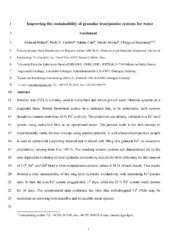Improving the sustainability of granular iron/pumice systems for water treatment.
Preprint2013
DOI: https://doi.org/10.1016/j.jenvman.2013.02.042
Persistent URL: http://resolver.sub.uni-goettingen.de/purl?gldocs-11858/7036
Persistent URL: http://resolver.sub.uni-goettingen.de/purl?gldocs-11858/7036
Bilardi, Stefania; Calabrò, Paolo S.; Caré, Sabine; Moraci, Nicola; Noubactep, Chicgoua, 2013: Improving the sustainability of granular iron/pumice systems for water treatment.. In: Bilardi, Stefania; Calabrò, Paolo S; Caré, Sabine; Moraci, Nicola; Noubactep, Chicgoua (2013): Improving the sustainability of granular iron/pumice systems for water treatment. - Journal of environmental management, Vol. 121, p. 133-41, DOI: 10.1016/j.jenvman.2013.02.042.
 |
Metallic iron (Fe(0)) is currently used in subsurface and above-ground water filtration systems on a pragmatic basis. Recent theoretical studies have indicated that, to be sustainable, such systems should not contain more than 60% Fe(0) (vol/vol). The prediction was already validated in a Fe(0)/sand system using methylene blue as an operational tracer. The present work is the first attempt to experimentally verify the new concept using pumice particles. A well-characterized pumice sample is used as operational supporting material and is mixed with 200 g of a granular Fe(0), in volumetric proportions, varying from 0 to 100%. The resulting column systems are characterized (i) by the time dependent evolution of their hydraulic conductivity and (ii) for their efficiency for the removal of Cu(II), Ni(II), and Zn(II) from a three-contaminants-solution (about 0.3 mM of each metal). Test results showed a clear sustainability of the long term hydraulic conductivity with decreasing Fe(0)/pumice ratio. In fact, the pure Fe(0) system clogged after 17 days, while the 25% Fe(0) system could operate for 36 days. The experimental data confirmed the view that well-designed Fe(0) PRBs may be successful at removing both reducible and non-reducible metal species.
Statistik:
ZugriffsstatistikSammlung:
- Geologie [933]

